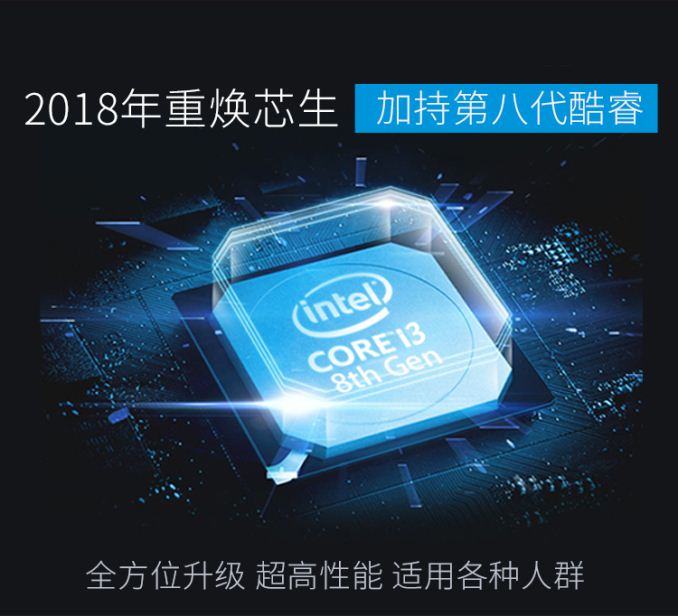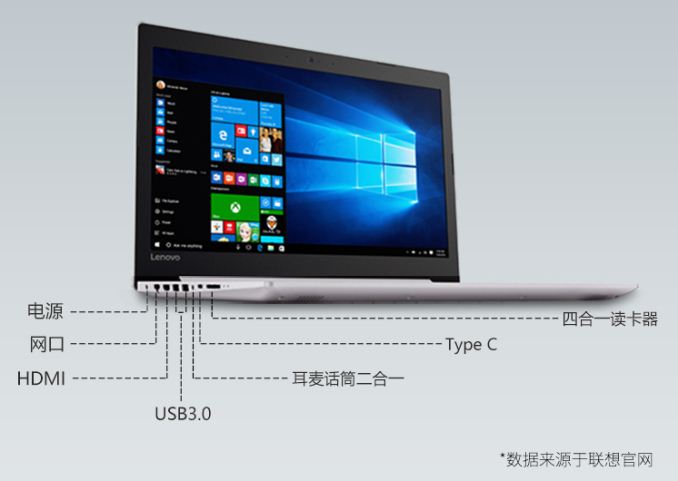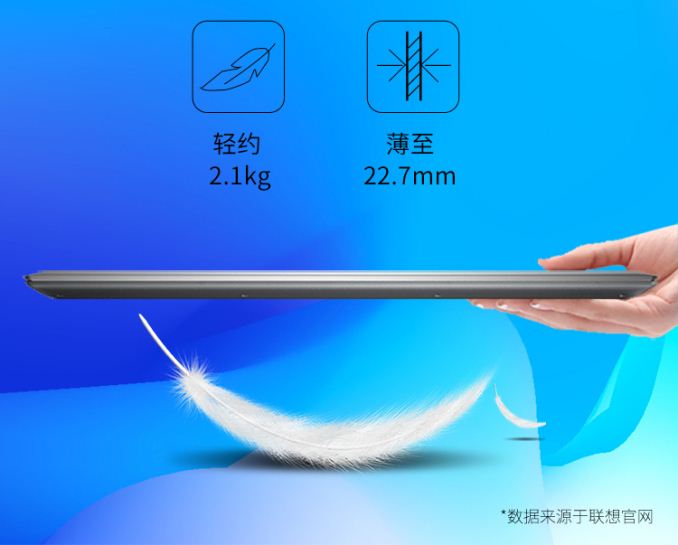First 10nm Cannon Lake Laptop Spotted Online: Lenovo Ideapad 330 for $449
by Ian Cutress on May 13, 2018 11:02 AM EST
In the fruitless efforts to get an answer from Intel as to exactly who is buying their first 10nm processors using the new Cannon Lake microarchitecture, we seem to now have an answer. Lenovo, one of Intel's biggest partners for laptops, has a new Ideapad 330 model available through an official distributor on China's online retailer JD.
The Ideapad 330 is a low end unit in both price and design. The bottom configuration is only 3299CNY, which converts to around $449 pre-tax. This model will feature the new 10nm Core i3-8121, a dual core processor based on Cannon Lake running at a 2.2 GHz base frequency. Pairing with this CPU will be an AMD Radeon RX 540 2GB, as the Intel processor does not have integrated graphics - technically the silicon for them is there, but in this design it is disabled. Our original source, Computerbase.de, states that the processor can turbo up to 3.1 GHz.
The Cannon Lake-based Lenovo Ideapad 330 will be a 15.6-inch laptop, however with a 1366x766 display and a TN panel, both metrics earmarked for low end devices. The stock configuration will be with 4GB of DDR4-2133 memory via a single SO-DIMM module, and a 500GB 5400RPM rotational hard drive for 3299CNY - however the listing on JD.com does offer upgrades up to 8GB of memory, a 1TB spinning drive, and a 256 GB solid state drive, for 3899CNY. The listing does not state which memory configurations are single/dual channel or what brand of storage drives are being used. In actual fact, the images on the listing state DDR4-2133, but the specifications list states DDR4-2400.
The unit will come in at 2.1 kg, and just under an inch thick at 22.7mm. The keyboard offers a full number pad , although it does come with half-height up and down arrow keys. Connectivity on the sides include an expandable gigabit Ethernet port, a HDMI port, two USB 3.0 Type-A ports, a Type-C port (of unknown standard), an SD card reader, a 3.5mm jack, a Kensington lock, and a CD/DVD drive. No metrics for battery life are given, however the retail page puts the component as an upgrade over the Core i3-6006U, Intel's low-end dual core Skylake-U processor for super budget systems.
| Lenovo Ideapad 330 / 10nm Cannon Lake | ||||
| CPU | Intel Core i3-8121U 10nm Cannon Lake Dual Core Four Threads 2.2 GHz Base 3.1 GHz Turbo (?) No Integrated Graphics |
|||
| GPU | AMD Radeon RX 540 2GB | |||
| Display | 15.6-inch 1366x768 TN | |||
| Memory | 4GB, DDR4-2133/2400 1 x SO-DIMM |
8GB, DDR4-2133/2400 ? x SO-DIMM |
||
| Storage | 500 GB HDD or 1TB HDD, 5400 RPM 128GB SSD or 256 GB SSD |
|||
| Dimensions | 378 x 260 x 22.7 mm 2.1 kg |
|||
| Battery | Unknown, listed as '5 hours' on JD.com | |||
| Features | Gigabit Ethernet port 2 x USB 3.0 Type-A 1 x USB ? Type-C 3.5mm jack HDMI output CD/DVD drive |
|||
| Price Low | 4GB DRAM | 500 GB HDD | - | 3299 CNY (~$445) |
| Price High | 8GB DRAM | 1TB HDD | 256 GB SSD | 4299 CNY (~$580) |
| OS | Windows 10 (variant unknown) | |||
This level of system is designed for users that 'just need a system', and is often the choice for businesses that need a mobile platform for their employees. The listing states that this device is for entry level business and student use, although the promotional material does go into the gaming performance of the graphics over other similarly priced solutions.
This machine listed online means that we can confirm that Intel is indeed shipping 10nm components into the consumer market, ending some speculation as to whether Intel was shipping) even though they said they were) and where those components were going. It doesn't solve the question as to how Intel's 10nm process is coming along, especially for the bread and butter of Intel's next generation of processors which should be the backbone of Intel's financials over the next few years. Shipping a low-end dual core processor with disabled graphics doesn't inspire confidence, especially as it is labelled under the 8th gen designation, and not something new and shiny under the 9th gen - although Intel did state in a recent earnings call that serious 10nm volume and revenue is now a 2019 target. These parts are, for better or worse, helping Intel generate some systems with the new technology. We've never before seen Intel commercially use low-end processors to introduce a new manufacturing process, although this might be the norm from now on.
Related Reading
Source: Computerbase.de, JD.com




















84 Comments
View All Comments
BurntMyBacon - Monday, May 14, 2018 - link
Not all IPS has an awful blue glow. Some have a neutral grey glow (o_O).I have not heard of a TN panel that has improved viewing angles in any meaningful way. There are, however, some nice TN displays that have good color accuracy and good coverage of the sRGB color space. Color issues were not an inherent failing of the TN technology, but rather the outcome of equipping a (cheap) TN display with only 6 bits of color depth per color. Similar color issue can be found on VA and IPS type displays with the same color depth.
BurntMyBacon - Monday, May 14, 2018 - link
Reading the comments below, I have to assume that I never used a TN panel quite as bad as what people are mentioning. I'll be more specific with my statement. I can see a color gradient when displaying a solid color on a 24" or larger TN display. This was true a decade ago and (in my experience) has not changed in any meaningful way despite the availability of rather higher quality TN displays today.tipoo - Monday, May 14, 2018 - link
I've actually found the opposite - years ago when TN was still what you'd get in high end laptops, effort was put in to tuning them, now they're what you get when scrounging for razor margin display deals. A lot of new laptops with TN look worse than old high end laptops with TN, because it's relegated to the low end now.willis936 - Monday, May 14, 2018 - link
I see a lot of comments along a similar vein here. While I've never been to mainland China I can say after visiting Taipei this sort of device is not a change in the status quo. You see this kind of low end, minimum in as many ways possible, device all over the place there. The people know what they're getting and they know their budget. I'd say in many ways the consumers there are more well informed on average than the consumers here.Don't worry, we'll get our Western machines that cost twice as much and have all of the nice-to-have essentials. There's no reason to make bad experiences worse to harm the low end segment.
Alexvrb - Sunday, May 13, 2018 - link
Frankly I think HDDs are the single biggest contributor to poor user impressions of "PCs", way more so than cheap panels. They get used to the speed and responsiveness of a modern smartphone/tablet, and then they fire up a $400-600 laptop with a spinner and think wow, PCs are garbage!If they get a cheap model and the display isn't as nice, they are more likely to blame that on the cheap display and not the platform as a whole. It's like buying an ultracheap TV, most people can at least grok that much. The 1TB HDD and 4GB of RAM isn't going to pop into their head when they're lamenting what garbage it is compared to their iGalaxyPhoneXX.
BurntMyBacon - Monday, May 14, 2018 - link
Have to agree here. If a $400 PC responds slower than a $200 tablet, people aren't going to have warm and fuzzy feelings about their purchase ... unless they are burning it ... out of spite.willis936 - Monday, May 14, 2018 - link
Really this is the fault of Windows more than the hard drive. I hate having to deal with linux but when I need to salvage data off of a dying drive Windows is out of the question. A slow to respond drive, even if there's no reason to access it, slows down every aspect of Windows for no good reason. It's absolutely stupid. Many times you really can't get around needing to do a lot of things on the disk, then it's the fault of the disk. I just feel that Windows deserves some blame for making the user experience unnecessarily worse.stephenbrooks - Monday, May 14, 2018 - link
Somehow, laptops have got more expensive and less responsive in Windows compared to 10 years ago. I had a Windows XP netbook that was pretty snappy in 2008. Now Windows 10 slows to a crawl on anything except expensive hardware.willis936 - Monday, May 14, 2018 - link
Even with XP's humble hardware requirements I had bad experiences with pre 2010 laptops. The abundance of SSDs even in the sub $500 category sometimes is a dream come true. Ten years ago SSDs were $10,000 for a hundred gigabyte drive.HStewart - Sunday, May 13, 2018 - link
I would not entirely blame this on Microsoft, Lenovo in my opinion is problem here - Ideapad are extremely cheap especially in their screens